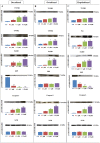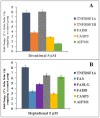Diatom-derived polyunsaturated aldehydes activate cell death in human cancer cell lines but not normal cells
- PMID: 24992192
- PMCID: PMC4081559
- DOI: 10.1371/journal.pone.0101220
Diatom-derived polyunsaturated aldehydes activate cell death in human cancer cell lines but not normal cells
Abstract
Diatoms are an important class of unicellular algae that produce bioactive polyunsaturated aldehydes (PUAs) that induce abortions or malformations in the offspring of invertebrates exposed to them during gestation. Here we compare the effects of the PUAs 2-trans,4-trans-decadienal (DD), 2-trans,4-trans-octadienal (OD) and 2-trans,4-trans-heptadienal (HD) on the adenocarcinoma cell lines lung A549 and colon COLO 205, and the normal lung/brunch epithelial BEAS-2B cell line. Using the viability MTT/Trypan blue assays, we show that PUAs have a toxic effect on both A549 and COLO 205 tumor cells but not BEAS-2B normal cells. DD was the strongest of the three PUAs tested, at all time-intervals considered, but HD was as strong as DD after 48 h. OD was the least active of the three PUAs. The effect of the three PUAs was somewhat stronger for A549 cells. We therefore studied the death signaling pathway activated in A549 showing that cells treated with DD activated Tumor Necrosis Factor Receptor 1 (TNFR1) and Fas Associated Death Domain (FADD) leading to necroptosis via caspase-3 without activating the survival pathway Receptor-Interacting Protein (RIP). The TNFR1/FADD/caspase pathway was also observed with OD, but only after 48 h. This was the only PUA that activated RIP, consistent with the finding that OD causes less damage to the cell compared to DD and HD. In contrast, cells treated with HD activated the Fas/FADD/caspase pathway. This is the first report that PUAs activate an extrinsic apoptotic machinery in contrast to other anticancer drugs that promote an intrinsic death pathway, without affecting the viability of normal cells from the same tissue type. These findings have interesting implications also from the ecological viewpoint considering that HD is one of the most common PUAs produced by diatoms.
Conflict of interest statement
Figures








Similar articles
-
Toxicity of diatom-derived polyunsaturated aldehyde mixtures on sea urchin Paracentrotus lividus development.Sci Rep. 2019 Jan 24;9(1):517. doi: 10.1038/s41598-018-37546-y. Sci Rep. 2019. PMID: 30679744 Free PMC article.
-
Diatom-derived oxylipins induce cell death in sea urchin embryos activating caspase-8 and caspase 3/7.Aquat Toxicol. 2016 Jul;176:128-40. doi: 10.1016/j.aquatox.2016.04.012. Epub 2016 Apr 22. Aquat Toxicol. 2016. PMID: 27130972
-
Teratogenic effects of diatom metabolites on sea urchin Paracentrotus lividus embryos.Mar Drugs. 2010 Mar 30;8(4):950-67. doi: 10.3390/md8040950. Mar Drugs. 2010. PMID: 20479962 Free PMC article.
-
The roles of FADD in extrinsic apoptosis and necroptosis.BMB Rep. 2012 Sep;45(9):496-508. doi: 10.5483/bmbrep.2012.45.9.186. BMB Rep. 2012. PMID: 23010170 Review.
-
Toxigenic effects of diatoms on grazers, phytoplankton and other microbes: a review.Ecotoxicology. 2010 Mar;19(3):493-511. doi: 10.1007/s10646-009-0434-y. Ecotoxicology. 2010. PMID: 19924531 Review.
Cited by
-
Toxigenic effects of two benthic diatoms upon grazing activity of the sea urchin: morphological, metabolomic and de novo transcriptomic analysis.Sci Rep. 2018 Apr 4;8(1):5622. doi: 10.1038/s41598-018-24023-9. Sci Rep. 2018. PMID: 29618786 Free PMC article.
-
Anticancer Compounds Derived from Marine Diatoms.Mar Drugs. 2020 Jul 9;18(7):356. doi: 10.3390/md18070356. Mar Drugs. 2020. PMID: 32660006 Free PMC article. Review.
-
Necroptosis in tumorigenesis, activation of anti-tumor immunity, and cancer therapy.Oncotarget. 2016 Aug 30;7(35):57391-57413. doi: 10.18632/oncotarget.10548. Oncotarget. 2016. PMID: 27429198 Free PMC article. Review.
-
Therapeutic Potential of Plant Oxylipins.Int J Mol Sci. 2022 Nov 23;23(23):14627. doi: 10.3390/ijms232314627. Int J Mol Sci. 2022. PMID: 36498955 Free PMC article. Review.
-
Toxigenic effects of sponges and benthic diatoms on marine invertebrates and their possible biotechnological applications.Sci Rep. 2024 Oct 25;14(1):25325. doi: 10.1038/s41598-024-74100-5. Sci Rep. 2024. PMID: 39455618 Free PMC article.
References
-
- Leflaive J, Ten-Hage L (2009) Chemical interactions in diatoms: role of polyunsaturated aldehydes and precursors. New Phytologist 184: 794–805. - PubMed
-
- Ianora A, Miralto A (2010) Toxigenic effects of diatoms on grazers, phytoplankton and other microbes. Ecotoxicology 19: 493–511. - PubMed
-
- Fontana A, d'Ippolito G, Cutignano A, Romano G, Lamari N, et al. (2007) LOX-induced lipid peroxidation mechanism responsible for the detrimental effect of marine diatoms on zooplankton grazers. Chembiochem 8: 1810–1818. - PubMed
-
- Pohnert G (2005) Diatom-Copepod interactions in plankton: the indirect chemical defense of unicellular algae. Chem Biochem 6: 1–14. - PubMed
Publication types
MeSH terms
Substances
LinkOut - more resources
Full Text Sources
Other Literature Sources
Research Materials
Miscellaneous

